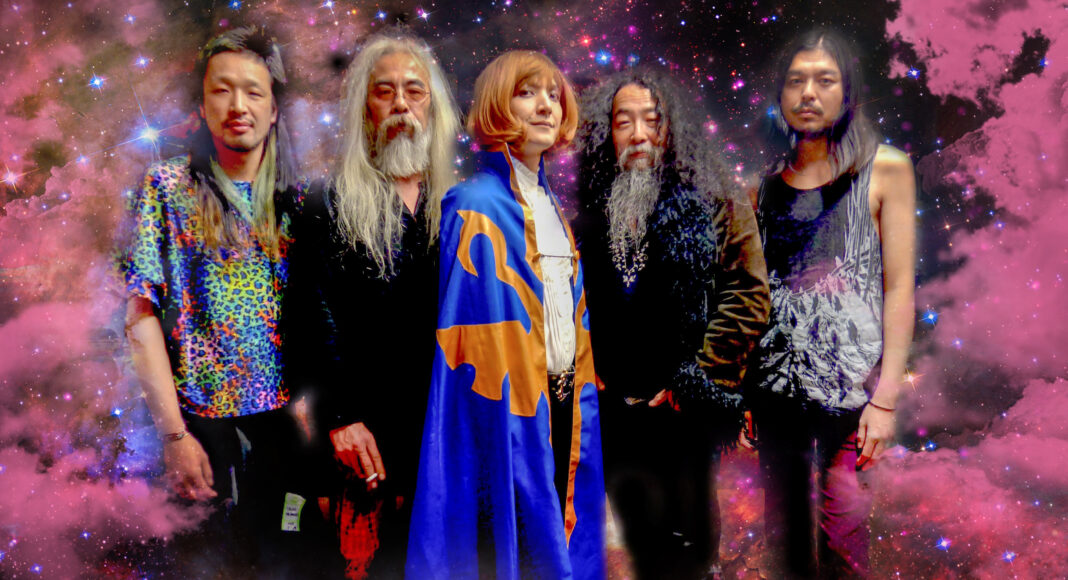Since their formation in 1995, Acid Mothers Temple & The Melting Paraiso UFO have adhered diligently to a single mantra: “Do whatever you want, don’t do whatever you don’t want.” The band’s stratospheric scope of work—a mix of psychedelic rock, layered instrumentals and avant-garde electronica—has occupied a prominent place in the experimental music scene for over 23 years, all the while shape-shifting and reinventing itself.
Led by frontman, guitarist, synth player and “speed guru” Kawabata Makoto, the band—formerly known as Acid Mothers Temple & The Cosmic Inferno, Acid Mothers Temple & Space Paranoid, Acid Mothers Temple SWR, and Acid Mothers Gong, among a handful of other names—comprises synth, theremin and harp player Higashi Hiroshi, guitarist and vocalist Mitsuko Tabata, drummer Satoshima Nani and bassist Wolf (also known as S/T).
The larger Acid Mothers Temple “soul collective,” however, is made up of over 30 past and present band members and associated performers who range from musicians and artists to dancers and farmers. Regardless of their background, they participate and collaborate in myriad ways with the band—often spontaneously or at a moment’s notice. Makoto explained in an email that Acid Mothers Temple shows are predominantly ad-libbed and performed based on feeling and intuition rather than an arranged setlist.
“For me, improvisation means composition, arrangement and playing music at the same time,” he writes in an email. “Deciding things makes me inflexible, and I need to be flexible. We communicate by music: if you listen to all sounds carefully, music will teach you what you should play.”
The recording process for the band is similarly unconstrained, but it’s clearly effective: Acid Mothers Temple have released an incredible 77 studio recordings since 1995, and that’s not even including Makoto’s solo projects or any of the band’s reincarnations.
“I first record my guitar and drums by improvising, then I start to compose songs, overdub and delete some things,” he says.
Part of Acid Mothers Temple’s reasoning for recording so prolifically is their commitment to releasing music through dozens of smaller, independent labels from around the world as well as self-releasing albums. For instance, in the past two years alone the band has recorded and sent out eight new studio-recorded albums to a handful of indie labels, two of which were eventually released. Though somewhat unconventional, Makoto explains that this process means their music can be accessed from a variety of avenues, regardless of one’s global location.
“If there are people who need our music, we should go and play for them and also make records for them,” he explains. “People give us lots of power and energy. If we slow down, it means not so many people need our music anymore.”
Acid Mothers Temple’s San Jose show at The Ritz is just one stop on the band’s ever-evolving, expanding world tour. Last year alone, they played 108 shows in 22 countries. This year, they will embark on a North American tour, followed by a European tour in autumn and a Japanese tour in December. That’s not to mention Makoto’s plan to also tour with two of his side projects—NANI∞GURU, a duo with drummer Nani; and Santa Ra, a space-jazz, rock & roll big band that he describes as “Sun Ra meets Santana” and includes stage get-ups inspired by the Afrofuturistic sun god himself.
And there’s no stopping anytime soon for Acid Mothers Temple. Makoto explains that in 2015, the band finished “episode one”—the group’s first 20 years as a band—and only just embarked on “episode two” in 2016.
“We are looking for the truth of the universe, which looks like a never-ending trip,” Makoto explains. “I’m not satisfied with the present in each moment. That’s why I can continue the band and playing music. If I am satisfied, then I should retire.”
Acid Mothers Temple
Mar 31, 8pm, $10+
The Ritz, San Jose



